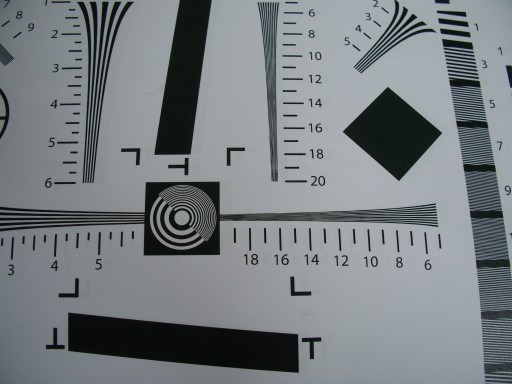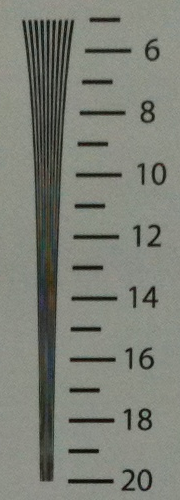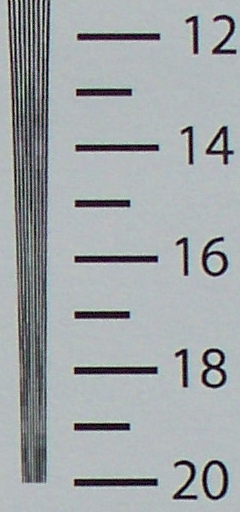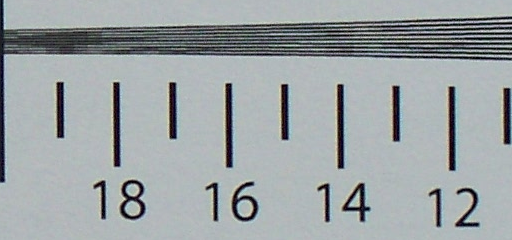iPhone 3GS camera's actual resolution
Posted by Wesley on
The dizzying ISO 12233 Test Chart
Point-and-shoot digital cameras have reached the end of the 'megapixel race' at around 12 megapixels, giving you a photo with the resolution of 4000x3000. One of the reasons for this peak is that the typical image sensors used in this class can produce only around 10 megapixels of actual data at best, and even less with internal post-processing applied. As a result, camera's 'actual' resolution will be far less than 4000x3000, even if the 'output' resolution is that large. Increasing output resolution any higher without better sensors would be no better than doing a digital zoom - bigger picture without more detail.
A smart shopper would therefore avoid blindly following the megapixel number on the spec sheet, and instead check the sensor size as well as the actual sample images posted in independent product reviews. In many professional reviews, an ISO 12233 Test Chart(partly seen above) is used to check the actual resolution of a camera. DPReview has been extensively using it.
So, why am I talking about this 'actual' and 'output' resolution today? I carry a nice compact digital camera - Kodak Z1085 IS - and an excellent smartphone - iPhone 3GS - with me at all times. The image quality is good for the given class, and they have the maximum native output resolution of 3648x2736 (10MP) and 2048x1536 (3MP), respectively. But I suddenly got curious as to what their actual resolution would be. Unfortunately, searching the internet did not come up with any resolution testing - it was time to do a little testing of my own...
To carry out the tests, I fetched a copy of the ISO 12233 Test Chart from Cornell University, and then printed out the PDF version of the chart onto an A3-size paper.
Using the chart is fairly straightforward. You align the camera's area of sight with the black and white arrows indicating the appropriate aspect ratio of the camera (in my case, 4:3). Then, you take the photo and analyze the test pattern. Numbers next to the test patterns indicate values in 100 times the Lines per Picture Height (LPH), and you should pick out the one close to where the lines (both black and white) start to blend into each other. If you chose 6, that would mean 600 LPH, or 600 lines of actual resolution available for the entire height of the photo.
You get to measure both the Horizontal and Vertical LPH. To find out how many lines of resolution is available for the width of the photo, you take the Horizontal LPH and multiply by the aspect ratio. In case of 600 Horizontal LPH, that would be 800. So the resulting 'actual resolution' comes to be 800x600 in this case.
Browsing the camera reviews that have LPH measurements, a good camera has an LPH value of 65% or more compared to each of the output dimension (e.g. for output height of 2304 pixels, it would get 1500 LPH or more). Multiplying height and width, you end up with about 42% the pixel count of the output resolution (e.g. 3072x2304 -> 7MP, 1500 LPH = 2000x1500 = 3MP).
This seems like a low figure, but keep in mind that this 'actual resolution' is the threshold for getting pixels that aren't blended next to each other. The camera can still make out details, if less clearly, using rest of the resolution.
Because the laser printer I used was limited to 600dpi output, the test pattern did get a bit distorted as it got really narrow, as you can see on the right. The narrowest point is about 1.5mm wide, so the printer can cram 35 pixels there. The test pattern is 17 lines (8 black, 7 white) wide, giving it only about 2 pixels each. This would have to be taken into account when seeing the test photos. Obviously, if I need to do a lot more serious testing, I'll have to find a better printer first.
With the chart printed out and hung on a wall, I lined up my iPhone 3GS and Z1085 IS in front of it and took the test photos. Here are the results - cropped, with no retouching, and saved as PNG to avoid JPEG artifacts:

iPhone 3GS Horizontal LPH
iPhone 3GS's Horizontal LPH is 1050 and Vertical LPH is 1000, giving us about 1450x1000, or 1.45MP, which is about 46% of the output resolution. So it's doing fairly well in terms of making the most out of the limited resolution it has to put up to in the first place.
Now let's check out the Kodak Z1085 IS.
The aforementioned distortion interferes with the analysis, but it's clear that Z1085 gets at least 1700 LPH, or 3.9MP. Not bad. I'll do a re-test if I can get ahold of a better printer.
There you have it. I'm sure Apple has better camera hardware readied for next generation iPhone, but the one in 3GS is doing fine.



